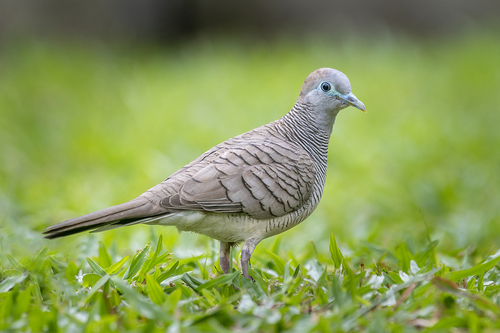
Zebra Dove
The Zebra Dove (Geopelia striata), also known as the Barred Ground Dove, is a small, long-tailed dove native to Southeast Asia. It's a popular pet bird and has been introduced widely across the globe, thriving in urban and suburban environments. Known for its distinctive, repetitive cooing call and barred plumage, it plays a role in seed dispersal and is a common sight in parks and gardens. Culturally, it is sometimes kept as a symbol of peace and good luck.
20-23 cm
Length
24-26 cm
Wingspan
Least Concern
Conservation Status
Distribution
Native to Southeast Asia, including Thailand, Malaysia, Singapore, Indonesia, and the Philippines. Introduced populations are established in Hawaii, Madagascar, Australia, and parts of the United States.
Lifespan
Up to 7 years in the wild; longer in captivity.
Zebra Dove's Habitat
Habitat Types
Open woodlands, Grasslands, Cultivated areas, Urban parks and gardens, Coastal scrub
Climate Zones
Tropical, Subtropical
Adaptations
Tolerant of human presence and disturbance; thrives in modified landscapes. Generalist diet allows it to utilize various food sources.
Variations
Several subspecies have been described, differing slightly in plumage and size, but their validity is sometimes debated.
Appearance
Breeding Plumage
No significant difference.
Seasonal Feather Changes
None
Sex Based Plumage Differences
Males may have slightly more pronounced barring, but differences are subtle.
Notable Features
Black-and-white barring on neck, breast, and wings, Bluish-gray facial skin, Long, pointed tail with white tips, Pinkish legs and feet
Diet and Feeding
Primary Foods
Seeds, Grains, Small insects, Fallen fruits
Foraging Behavior
Forages primarily on the ground, walking and pecking at seeds and other food items. Often seen in pairs or small groups.
Specializations
No significant specializations; generalist feeder.
Seasonal Diet Variations
May consume more insects during breeding season when protein needs are higher.
Behavior
Social Structure
Usually found in pairs or small family groups. May form larger flocks outside of the breeding season.
Communication
Soft, repetitive cooing vocalizations, Bowing and tail-fanning displays, Wing-clapping during courtship flights
Migration
Generally non-migratory, but may make local movements in response to food availability.
Territorial or Group Behaviors
Males defend small territories around the nest during breeding season.
Conservation
Threats
Habitat loss in some parts of its native range, Pesticide use in agricultural areas, Predation by introduced species (e.g., cats, rats) in some introduced populations
Protection Programs
Not currently subject to specific conservation programs due to its widespread abundance.
Local National Laws
Protected under general wildlife laws in many countries.
Population Trend
Stable
Population Estimates
Globally abundant; no precise population estimates available.
Interesting Facts
They are known for their rapid flight.
Zebra Doves can fly quickly in short bursts, which helps them evade predators.
They are prolific breeders.
Zebra Doves can raise multiple broods per year, contributing to their successful establishment in new areas.
They can drink brackish water.
This allows them to survive in coastal areas and on small islands with limited freshwater sources.
Faqs about Zebra Dove
What is the Zebra Dove's song like?
It has a soft, repetitive coo-coo-coo call, often described as soothing.
Are Zebra Doves good pets?
They can be, as they are relatively tame and easy to care for. However, they need a spacious enclosure and are not as interactive as some other pet birds.
Do Zebra Doves mate for life?
They typically form strong pair bonds, but may re-pair if a mate is lost.
What should I do if I find a baby Zebra Dove?
If it appears healthy and its parents are nearby, it's best to leave it alone. If it's injured or orphaned, contact a local wildlife rehabilitator. *Consult a professional for medical or expert advice.*
Copyright @ Nature Style Limited. All Rights Reserved.
 English
English